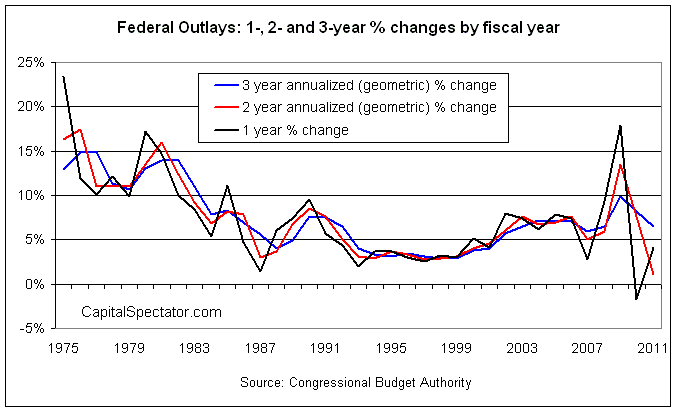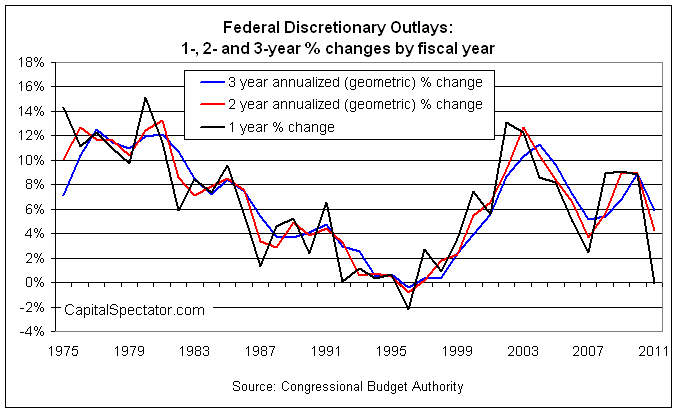How fast is the federal government's spending rising? It's a politically charged question these days, of course, and so there's an excess of spin attached to the discussion of government budgets at the moment. Fortunately, the offending numbers are easily located and dissected, courtesy of the Congressional Budget Office's "Budget and Economic Outlook: Fiscal Years 2012 to 2022" report (specifically: the historical data in tables F-1 and F-3). The results may enrage or inspire you, depending on your political persuasion and budgetary assumptions. But the first intelligent step in any debate is to take a sober look at the data, assuming it's available. Oh, yes, one other necessary condition for informed analysis: no screaming, please.
Let's start with total federal outlays on a fiscal year basis. For perspective, the chart below compares a simple one-year percentage change with its annualized (geometric) two- and three-year counterparts. The recent surge in growth rates is due to fiscal year 2009, but there's been a sharp slowdown in the pace of federal spending in the two subsequent years. The future is unclear on this front, but the past is crystal.
As you can see, the latest growth rates for FY2011 don't look radically out of line with recent history. True, it's debatable if we can even afford historically moderate rates any longer. Meanwhile, the annualized three-year rate of 6.5% is near its average pace since the mid-1970s. That's higher than what we saw in the second half of the late-1990s, but one can counter that a 6.5% rate is roughly in line with the trend in the decade before the Great Recession hit. The debate about whether it's too high is a separate question, of course, but if history's a guide it's hard to argue there's been a dramatic surge in the rate of growth. That may not mean much with mounting deficits, but for simplicity let's stick with spending rates. One budgetary challenge at a time, please.
Another relevant point: Most federal outlays fall under the heading of mandatory spending, which includes the entitlement programs, such as Social Security and Medicare. Because mandatory spending is to a degree an automated process, it's reasonable to review the trend in so-called discretionary spending in isolation. These are the programs that receive regular up or down votes. It's interesting to note that discretionary spending rates have dropped in FY2011. Once again, the three-year average of nearly 6% is near the average rate for the past three decades-plus. That looks high compared with the late-1990s, but it's well below the pace set in 2002-2006.
The data above shouldn't be used to dismiss the budgetary challenges that face the U.S. At the same time, the inflammatory language about government spending exploding in a way that's unprecedented looks overblown, based on the historical record. Granted, there's more than one way to look at federal spending. For example, a more troubling comparison can be found via government spending as a percentage of the economy (gross domestic product). As I noted last week, overall federal outlays are running at unusually high levels of late. On the other hand, discretionary spending's growth trend looks less troubling.
The main problem, in sum, is with mandatory spending (i.e., entitlement programs). In 1972, mandatory spending consumed 44% of federal outlays. In subsequent decades, mandatory spending has trended higher to the point that for the past 10 years it routinely accounted for well over 60% of the budget. Given the demographics of the country, that share is on track to rise further. Looking at probable growth rates for the economy, however, it's clear that entitlement spending's expected growth is unsustainable. Budget reform, to state the obvious, is critical.
In short, it's all about entitlement reform. There are no easy solutions to controlling government sprawl. But if there's any hope of resolving the very real financial challenges that await, surely it starts with a sober look at the numbers. That may be asking too much of the political class, but hope springs eternal.
- English (UK)
- English (India)
- English (Canada)
- English (Australia)
- English (South Africa)
- English (Philippines)
- English (Nigeria)
- Deutsch
- Español (España)
- Español (México)
- Français
- Italiano
- Nederlands
- Português (Portugal)
- Polski
- Português (Brasil)
- Русский
- Türkçe
- العربية
- Ελληνικά
- Svenska
- Suomi
- עברית
- 日本語
- 한국어
- 简体中文
- 繁體中文
- Bahasa Indonesia
- Bahasa Melayu
- ไทย
- Tiếng Việt
- हिंदी
Growth Rates And Government Spending
Published 05/30/2012, 07:06 AM
Updated 07/09/2023, 06:31 AM
Growth Rates And Government Spending
Latest comments
Loading next article…
Install Our App
Risk Disclosure: Trading in financial instruments and/or cryptocurrencies involves high risks including the risk of losing some, or all, of your investment amount, and may not be suitable for all investors. Prices of cryptocurrencies are extremely volatile and may be affected by external factors such as financial, regulatory or political events. Trading on margin increases the financial risks.
Before deciding to trade in financial instrument or cryptocurrencies you should be fully informed of the risks and costs associated with trading the financial markets, carefully consider your investment objectives, level of experience, and risk appetite, and seek professional advice where needed.
Fusion Media would like to remind you that the data contained in this website is not necessarily real-time nor accurate. The data and prices on the website are not necessarily provided by any market or exchange, but may be provided by market makers, and so prices may not be accurate and may differ from the actual price at any given market, meaning prices are indicative and not appropriate for trading purposes. Fusion Media and any provider of the data contained in this website will not accept liability for any loss or damage as a result of your trading, or your reliance on the information contained within this website.
It is prohibited to use, store, reproduce, display, modify, transmit or distribute the data contained in this website without the explicit prior written permission of Fusion Media and/or the data provider. All intellectual property rights are reserved by the providers and/or the exchange providing the data contained in this website.
Fusion Media may be compensated by the advertisers that appear on the website, based on your interaction with the advertisements or advertisers.
Before deciding to trade in financial instrument or cryptocurrencies you should be fully informed of the risks and costs associated with trading the financial markets, carefully consider your investment objectives, level of experience, and risk appetite, and seek professional advice where needed.
Fusion Media would like to remind you that the data contained in this website is not necessarily real-time nor accurate. The data and prices on the website are not necessarily provided by any market or exchange, but may be provided by market makers, and so prices may not be accurate and may differ from the actual price at any given market, meaning prices are indicative and not appropriate for trading purposes. Fusion Media and any provider of the data contained in this website will not accept liability for any loss or damage as a result of your trading, or your reliance on the information contained within this website.
It is prohibited to use, store, reproduce, display, modify, transmit or distribute the data contained in this website without the explicit prior written permission of Fusion Media and/or the data provider. All intellectual property rights are reserved by the providers and/or the exchange providing the data contained in this website.
Fusion Media may be compensated by the advertisers that appear on the website, based on your interaction with the advertisements or advertisers.
© 2007-2024 - Fusion Media Limited. All Rights Reserved.
